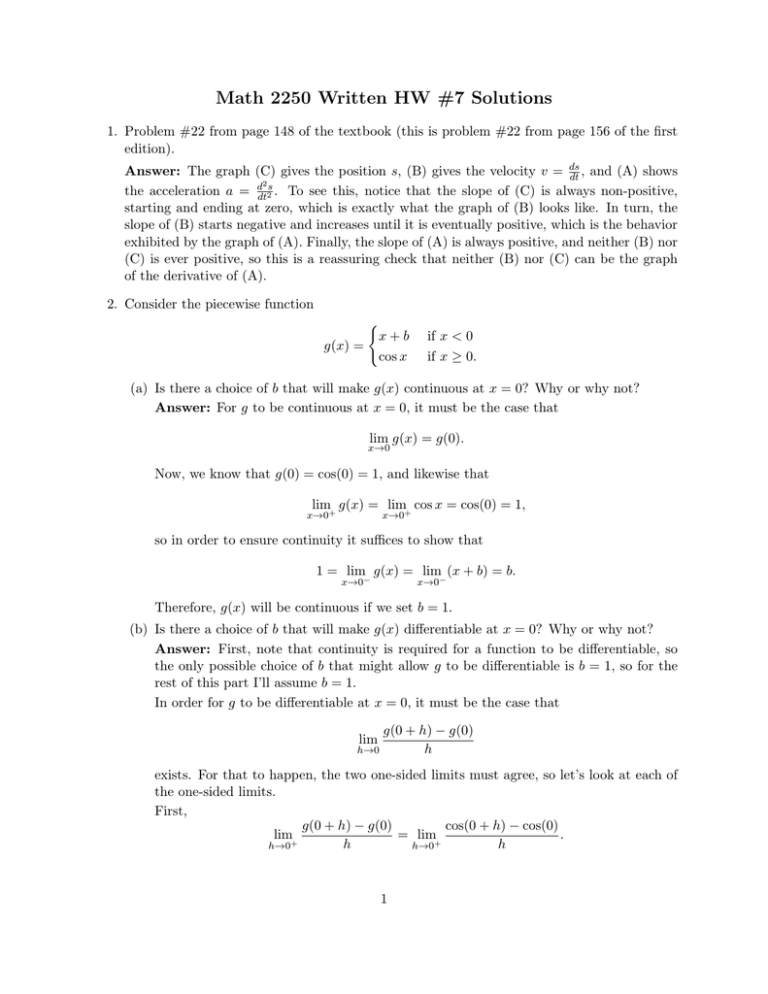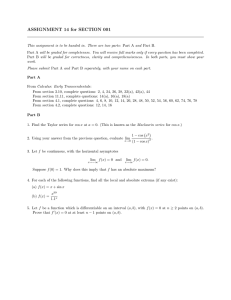Math 2250 Written HW #7 Solutions
advertisement

Math 2250 Written HW #7 Solutions 1. Problem #22 from page 148 of the textbook (this is problem #22 from page 156 of the first edition). Answer: The graph (C) gives the position s, (B) gives the velocity v = ds dt , and (A) shows 2 the acceleration a = ddt2s . To see this, notice that the slope of (C) is always non-positive, starting and ending at zero, which is exactly what the graph of (B) looks like. In turn, the slope of (B) starts negative and increases until it is eventually positive, which is the behavior exhibited by the graph of (A). Finally, the slope of (A) is always positive, and neither (B) nor (C) is ever positive, so this is a reassuring check that neither (B) nor (C) can be the graph of the derivative of (A). 2. Consider the piecewise function ( x+b g(x) = cos x if x < 0 if x ≥ 0. (a) Is there a choice of b that will make g(x) continuous at x = 0? Why or why not? Answer: For g to be continuous at x = 0, it must be the case that lim g(x) = g(0). x→0 Now, we know that g(0) = cos(0) = 1, and likewise that lim g(x) = lim cos x = cos(0) = 1, x→0+ x→0+ so in order to ensure continuity it suffices to show that 1 = lim g(x) = lim (x + b) = b. x→0− x→0− Therefore, g(x) will be continuous if we set b = 1. (b) Is there a choice of b that will make g(x) differentiable at x = 0? Why or why not? Answer: First, note that continuity is required for a function to be differentiable, so the only possible choice of b that might allow g to be differentiable is b = 1, so for the rest of this part I’ll assume b = 1. In order for g to be differentiable at x = 0, it must be the case that g(0 + h) − g(0) h→0 h lim exists. For that to happen, the two one-sided limits must agree, so let’s look at each of the one-sided limits. First, g(0 + h) − g(0) cos(0 + h) − cos(0) lim = lim . + + h h h→0 h→0 1 But, since cos x is differentiable at x = 0, the above is equal to cos(0 + h) − cos(0) d lim = (cos x) = − sin(0) = 0. h→0 h dx x=0 On the other hand, lim h→0− g(0 + h) − g(0) [(0 + h) + 1] − cos(0) h+1−1 h = lim = lim = lim =1 h h h h→0− h→0− h→0− h (equivalently, I could have noted that this limit is equal to the derivative of x + 1 at x = 0). Since 1 = 6 0, we see that the two one-sided limits don’t agree, meaning that lim h→0 g(0 + h) − g(0) h does not exist. Therefore, g(x) cannot possibly be differentiable no matter what b is chosen. 3. Assume that g 0 (3) = −1, h0 (2) = 5, and h(2) = 3. If f (x) = (g ◦ h)(x), what is f 0 (2)? Answer: By the chain rule, f 0 (x) = g 0 (h(x)) · h0 (x) for any x. In particular, for x = 2, f 0 (2) = g 0 (h(2)) · h0 (2) = g 0 (3) · h0 (2) = (−1) · 5 = −5. 2




